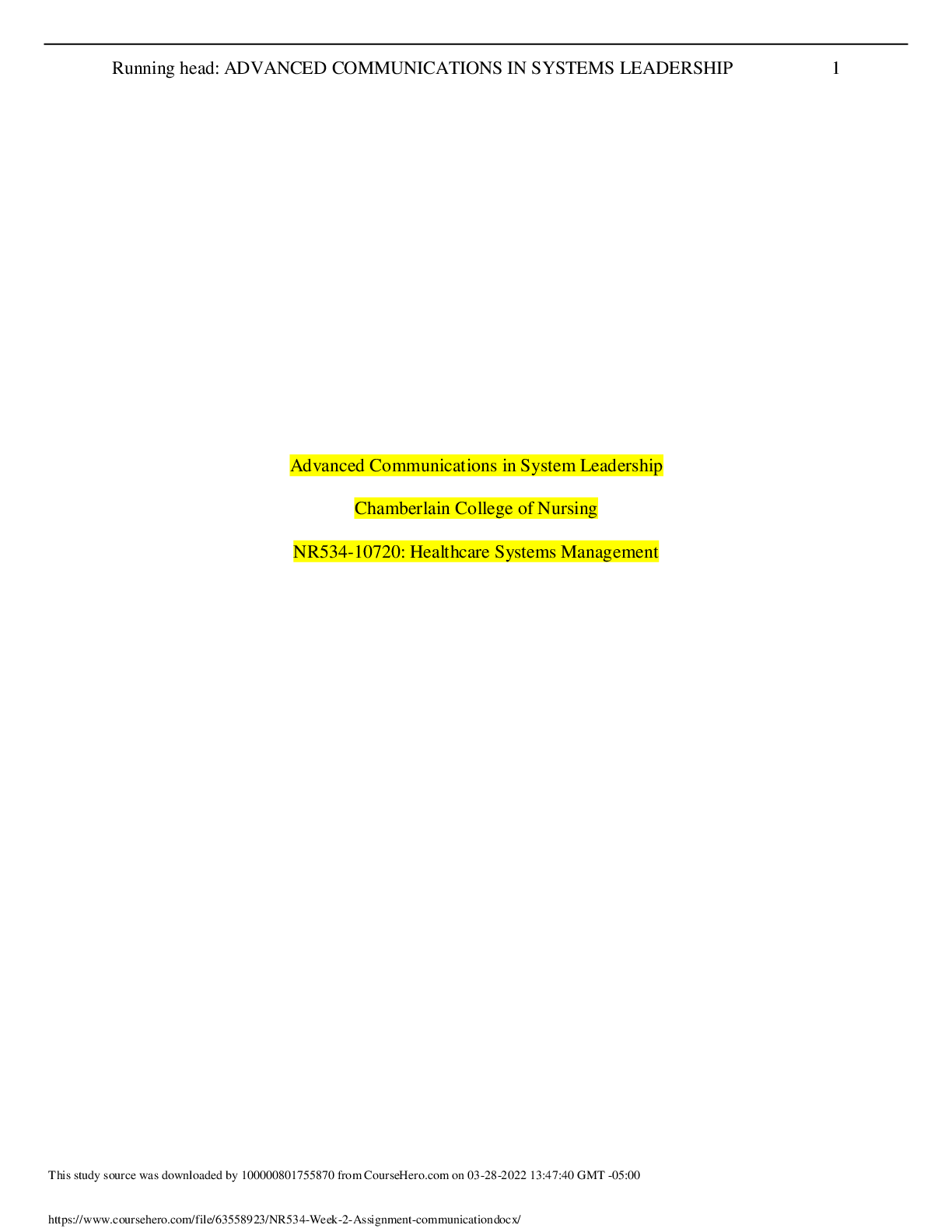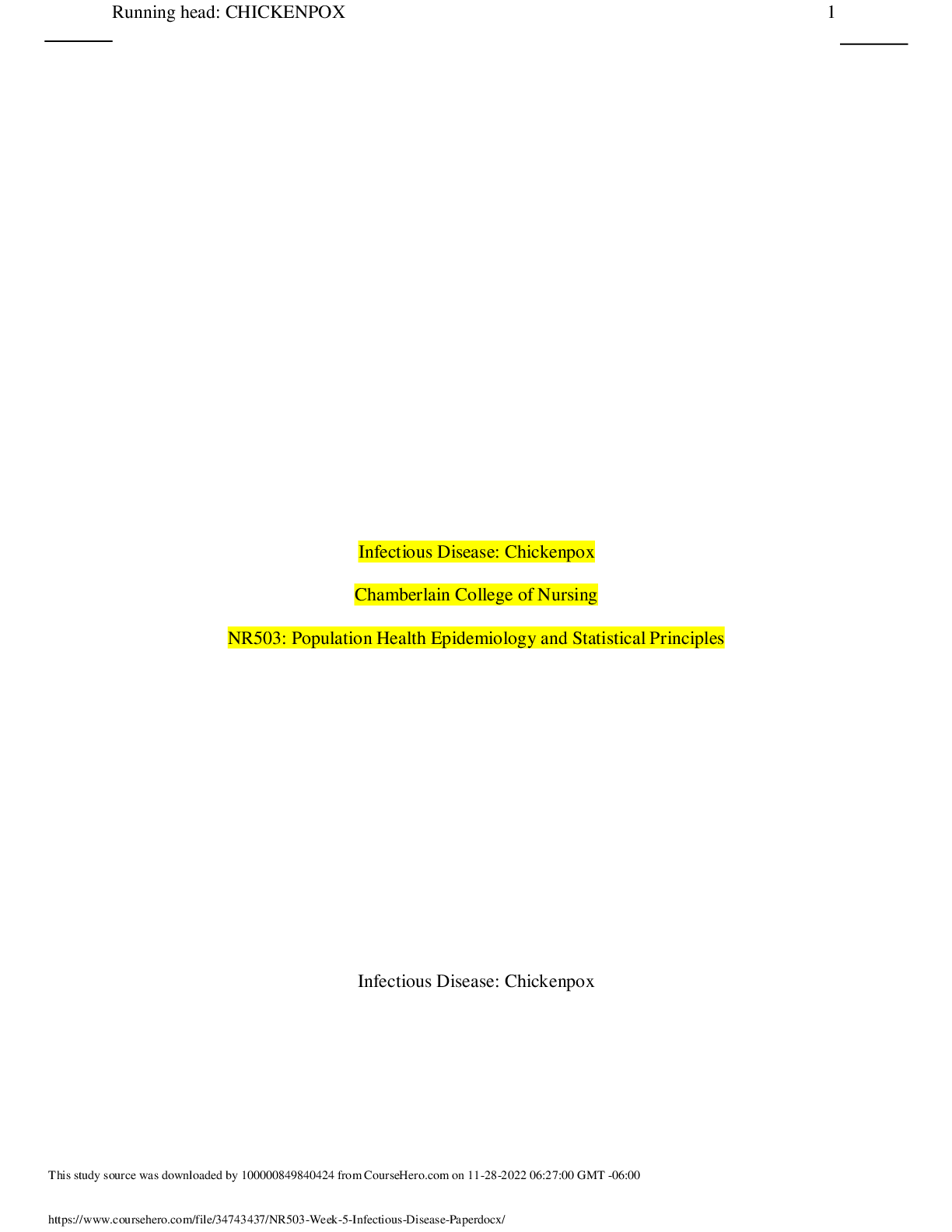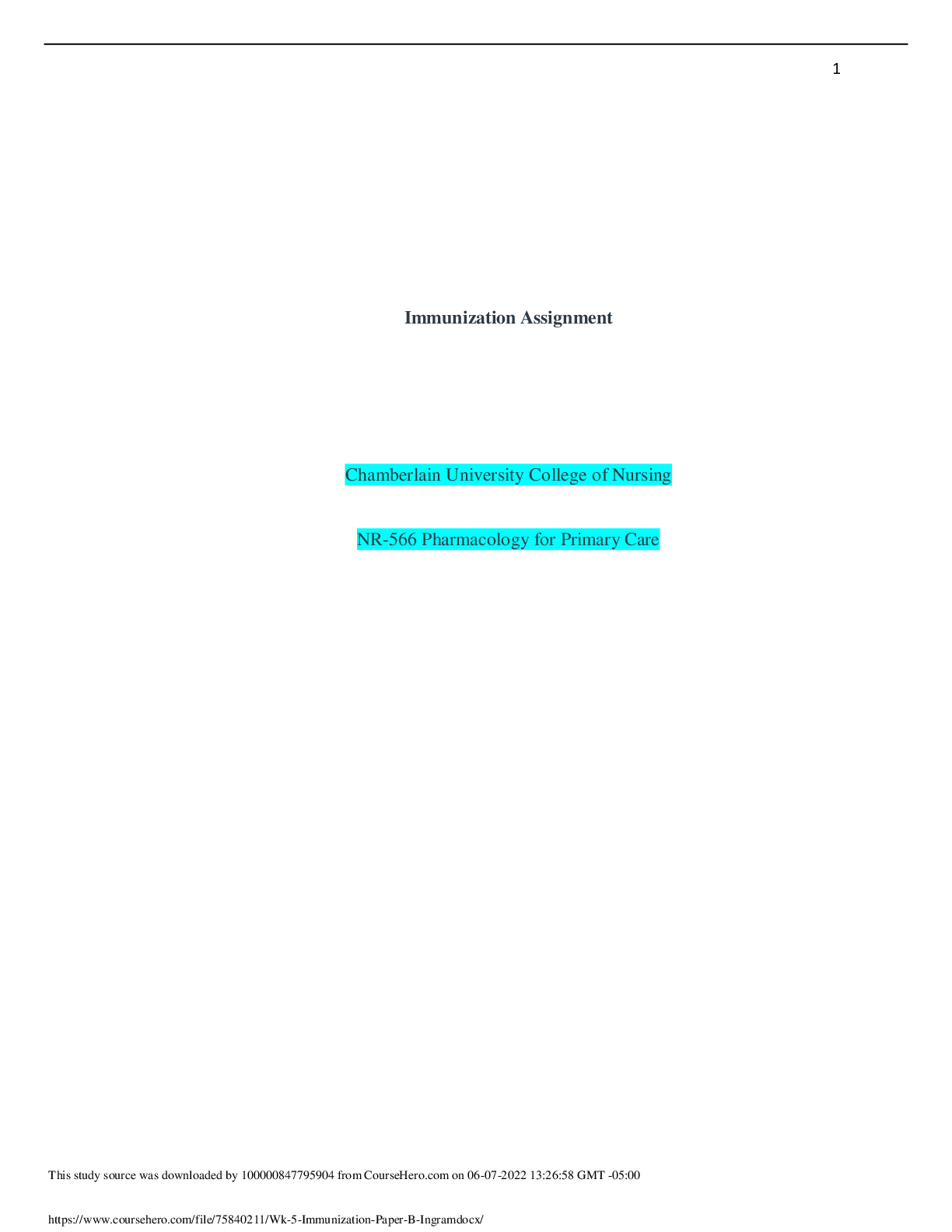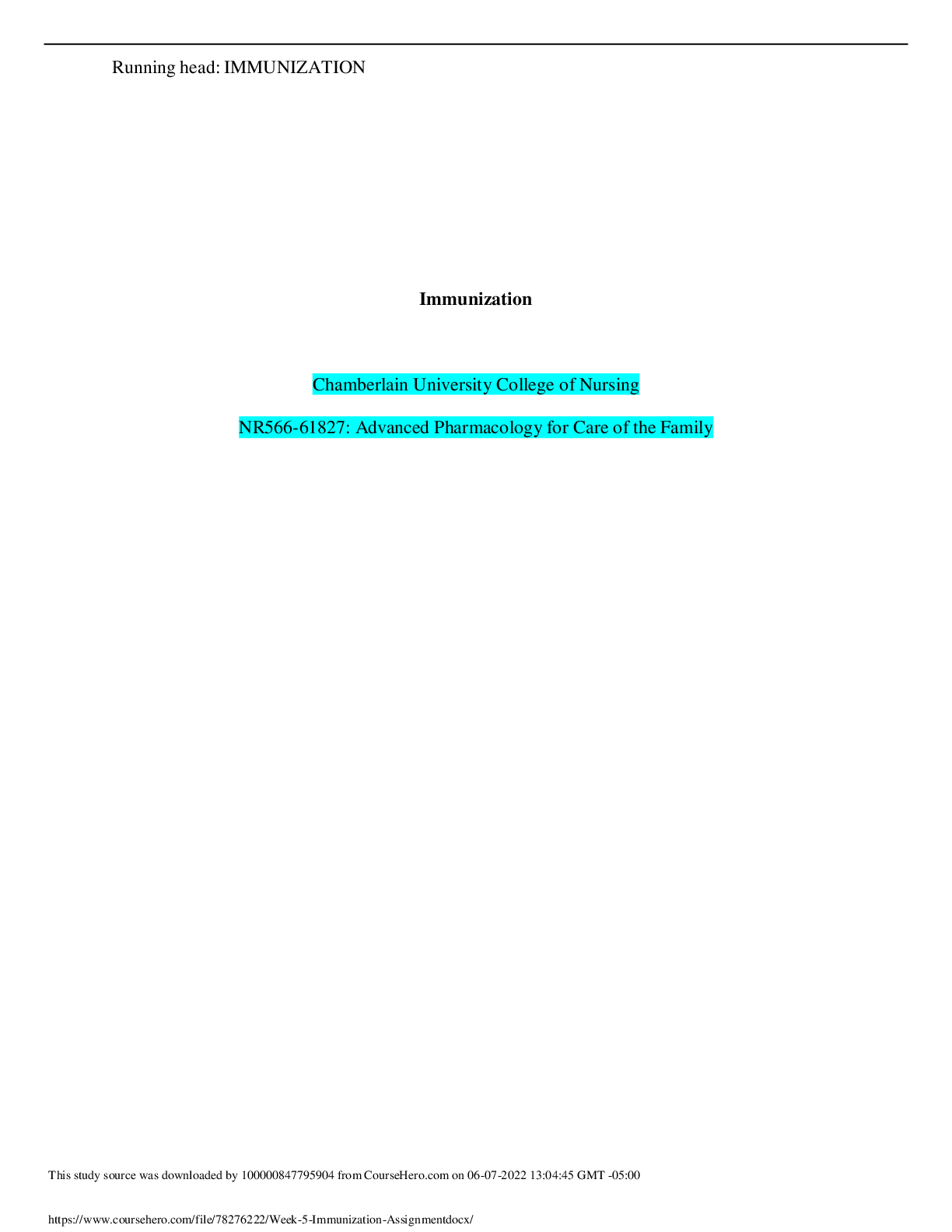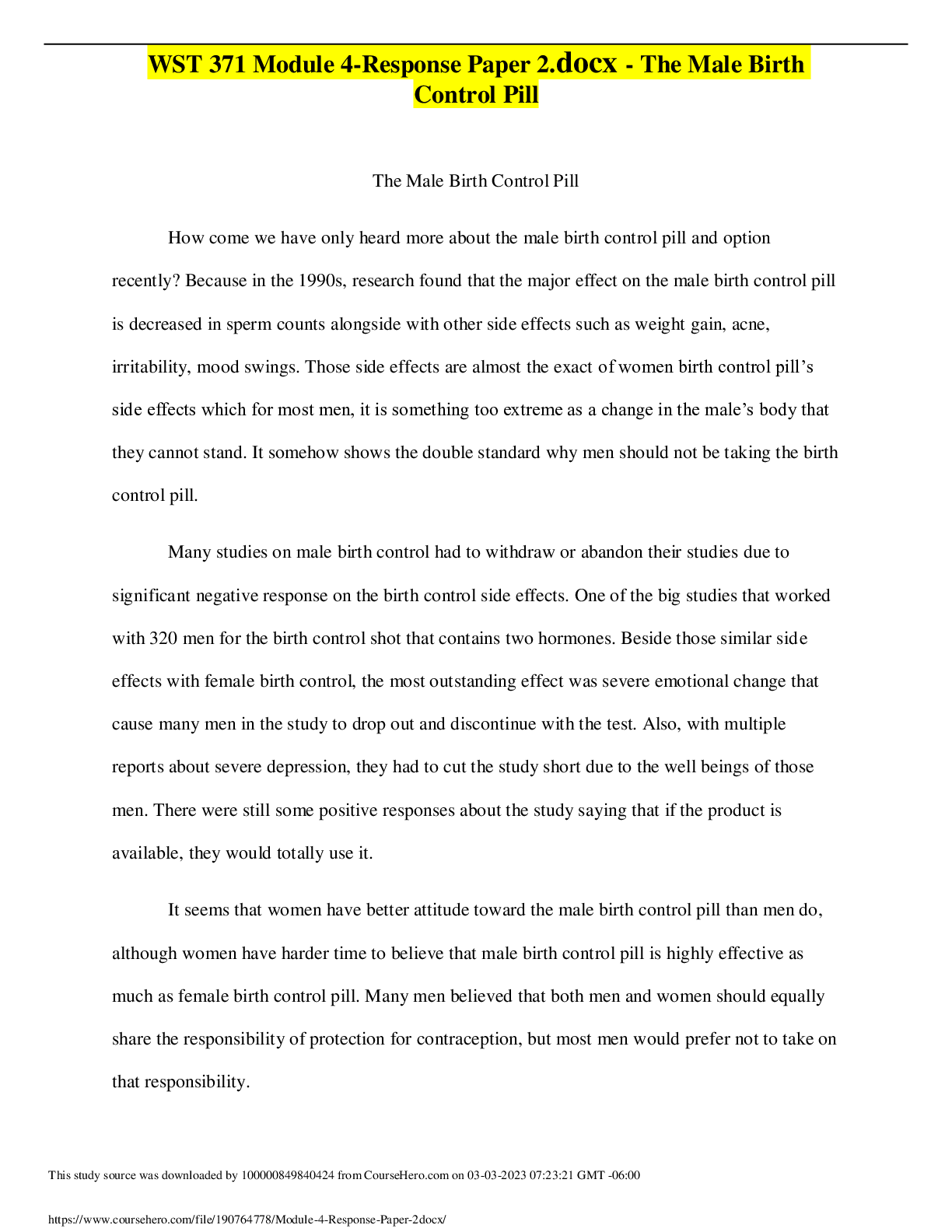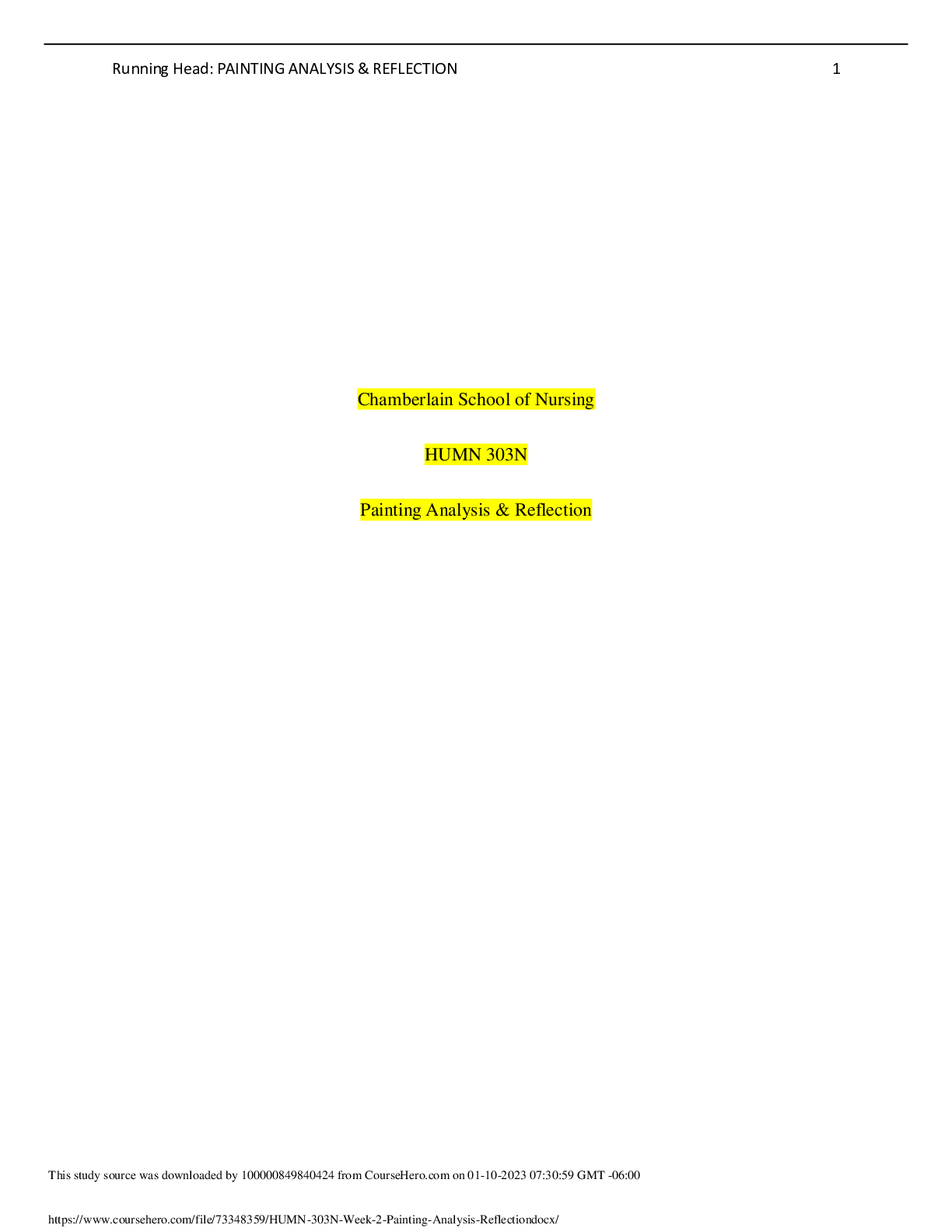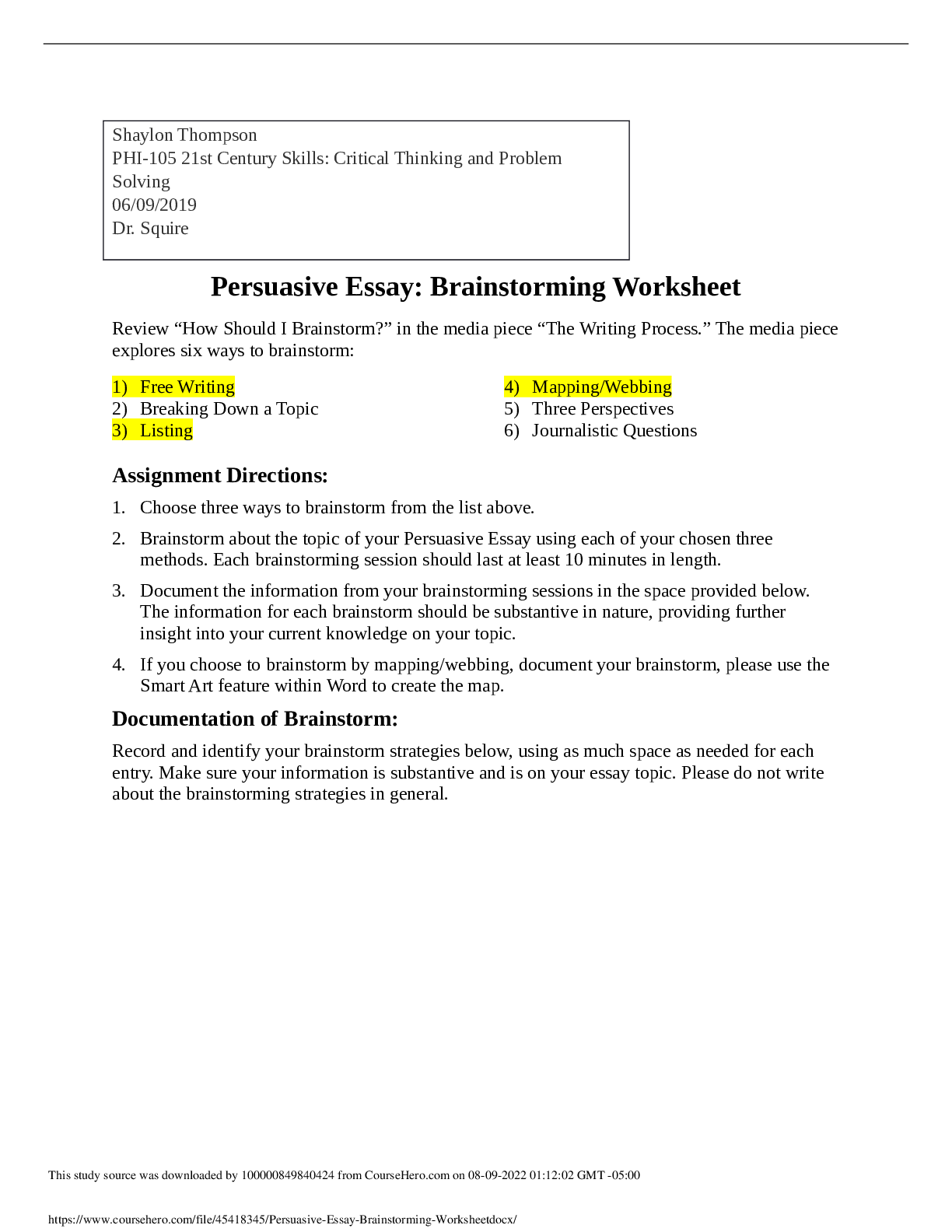*NURSING > ESSAY > NR-509 Week 7 Alternative Writing Assignment: Health History & Physical Examination Techniques (All)
NR-509 Week 7 Alternative Writing Assignment: Health History & Physical Examination Techniques
Document Content and Description Below
Alternative Writing Assignment Chamberlain College of Nursing NR 509 Advanced Physical Assessment Alternative Writing Assignment Family nurse practitioners must have well-honed assessment s... kills in order to provide high quality and efficient care to the populations in which they care for. Having a thorough understanding of the body systems that require assessment as well as what abnormalities that can occur will help the nurse practitioner glean information from the subjective and objective assessments more readily. Special adaptation of assessment skills and history taking must be performed for various populations including pediatric, pregnant, and geriatric. The purpose of this assignment is to identify and articulate advanced assessment health history and physical examination techniques which are relevant to a focused body system, differentiate normal and abnormal findings with regard to a disease or condition that impacts the body system, and adopt advanced assessment skills, if necessary, to suit the needs of specific patient populations. Body System The specific body system that will be discussed in this assignment will be the respiratory system. The respiratory system is the primary site for gas exchange which helps the body obtain oxygen and dispose of carbon dioxide. This process is imperative to all vital functions in the body. Physiology The primary organ responsible for gas exchange of oxygen and carbon dioxide include the lungs. Blood collects the oxygen from the lungs and carry it to various parts of the body where it is needed for metabolic processes to occur. During the process of cell metabolism, the red blood cells collect the carbon dioxide and transport it back to the lungs where it leaves the body upon exhalation. Upon inhalation oxygen enters the nose or mouth. The trachea branches into the bronchi, which are two tubes that carry air into each level both the right and left. The bronchial tubes are lined with cilia. Cilia move back and forth; this helps filter foreign material from the respiratory system. Mucus which is a sticky fluid collects dust, bacteria, and other matter that has invaded the lungs. Mucus is expelled through sneezing, coughing, spiting, or swallowing. The bronchial tubes lead to the lobes of the lungs. The right lung has three lobes and the left has two. At the terminal end of the lobes are alveoli which is where the primary gas exchange occurs. Health History Questions Taking a proper health history examination should start with hand washing and any other isolation techniques that may be applicable to the respiratory system such as airborne or droplet precautions. The next step in the health history examination would be to introduce one's self to the patient. Providing one’s name, credentials, and role within the care team. Questions that would be useful when taking a respiratory history include, please describe the problem that caused you to come in today? How has this condition impacted your activities? How often does the cough occur? How long has the cough been occurring? Does anything make the cough worse? Does anything make the cough better? Have you used anything to treat the cough at home? Do you smoke? What profession do you work in? Is there any family history of respiratory problems? During all aspects of the assessment, observe for fatigue or discomfort especially when the patient is trying to speak as a patient who cannot complete a full sentence is an ominous sign of impending respiratory distress. Objective Data After the subjective data is collected the examiner will move on to the objective data collection portion which includes, inspection, palpation, percussion, and auscultation. Inspection of the respiratory system will usually begin with observation of the facial expressions, skin color, moisture, whether or not the patient is clammy or dry, and temperature of the skin. Skin should be warm and dry and have a uniform complexion that is consistent with the patient's ethnic background. Facial expressions should be relaxed with no signs of distress. If the patient looks as if they are consciously working on breathing this could be a sign that a patient is experiencing respiratory distress. Inspection of nail beds, lips and mouth are also important clues when assessing the respiratory system. Cyanosis of the fingernails could be secondary to respiratory issues. Clubbing of the fingernails could be indicative of chronic states of hypoxia such as those experienced in patients with chronic obstructive pulmonary disease. Inspecting the neck is also important to observe for any use of the accessory muscles of breathing which would be indicative of active respiratory distress. Another important factor to observe is the patient's posture. A posture where the patient is bent forward with their arms on their knees is called tripod posture. This posture is the body's mechanism to improve lung function but is a sign of active respiratory distress in most patient populations. Observing the respiratory rate is important as a normal respiratory rate for adults is 14 to 20 breaths per minute. Observing the shape of the chest for symmetrical equal chest rise and fall. An abnormal finding could be unilateral rising and falling of the chest which would be indicative of flail chest after a trauma. Palpation involves examining the trachea. The examiner should note that it is midline. Palpation of the anterior and posterior chest can be performed with the palms of both hands. The chest should not be tender, the patient should not complain of pain, and there should be no visible or palpable masses. A crackling feel to the skin is called subcutaneous emphysema also known as crepitus which is where air is introduced into the subcutaneous tissue. The examiner can also place their hands in the intercostal spaces and have the patient repeat the words ninety- nine to assess tactile fremitus. Percussion of the chest wall would be the next step in the assessment of the respiratory system. Percussion is performed by striking the outstretched middle finger of the non-dominant hand with the middle finger of the dominant hand listening for dullness, tympani, and hyper resonance. Dullness can be indicative of fluid collection such as in pneumonia. Hyper resonance can be over inflated lungs such as those in the case of chronic obstructive pulmonary disease patients. The last step in the respiratory assessment is auscultation of the lung fields. The patient should be sitting upright and the examiner should ask the patient to breathe deeply through their mouth and exhale through their mouth in order to provide the proper aeration of the lung fields which will aid in auscultation. Using the diaphragm of the stethoscope the examiner should assess over the apices of the lungs and alternate from side-to-side listening all the way down to the bases of both lungs. This should be done anteriorly and posteriorly. The soft sounds of the lung fields are vesicular breath sounds. bronchial sounds are heard over the larger airways and can also be heard over the trachea. The examiner should be auscultating for adventitious lung sounds in all fields. Crackles are the lung sounds heard through fluid in the lung which could be indicative of infection such as pneumonia or fluid overload such as pulmonary edema. Wheezing is a musical sound that is often heard when there is bronchial constriction secondary to asthma or another reactive airway disease. Rhonchi sounds are produced by fluid in the narrow bronchial airways which causes a coarse rattling sound to be heard. Stridor is a high-pitched sound that is indicative of a medical emergency because it is usually secondary to a partial airway obstruction Special Procedures Spirometry is an important test that can be performed in the office setting. This test can assess the inspiratory volume and expiratory volume that the patient exhibits. It can be useful in identifying asthma as well as other reactive airway diseases. A spirometry assessment can verify the effectiveness of the treatment that is being provided to the patients such as inhaled corticosteroids and bronchodilators. Spirometry is cost effective and helps decrease delays that are associated with sending the patient to centers that would perform this testing (Coates, Tamari, & Graham, 2014). Often times patients may not be compliant with care modalities secondary to the fact that it is not convenient. Utilizing these techniques in the office setting can improve patient satisfaction as well as improve compliance with care modalities that are instituted in the primary care setting. Adaptation of Physical Assessment Special populations include, infant, pediatric, pregnant women, and geriatric adults. These special patient populations require that different techniques be employed in order to ascertain the information that is important to the diagnosis. Infant/Pediatric When taking a history for an infant, the parents will be the primary source of information and it is important to build a rapport with them as much as the infant/child. Ask the parents about any episodes of respiratory distress, cyanosis, apnea, if any family members smoke in the house, how far along the patient was in gestational maturity prior to birth and whether or not there was a history of mechanical ventilation for the patient. In taking a history for a child, ask parents about any history of asthma, if there is a history of asthma it is important to ascertain the effectiveness of current asthma treatment. Pregnancy According to LoMauro and Aliverti (2015) pregnancy does not usually affect the respiratory system but pregnancy can place women in hypercoaguable states which can predispose them to deep vein thrombosis which can in turn lead to pulmonary embolism. Pregnant women pose a unique challenge as the wellbeing of the fetus must be taken into account and certain treatment modalities must either be eliminated from the plan or altered entirely. Women with preexisting lung diseases should be counseled on the importance of planning their pregnancies. High risk pregnant women should be referred to high risk obstetricians and pulmonologists if they possess preexisting respiratory conditions. By making the proper referrals the primary care nurse practitioner can help the pregnant patient stay healthy and mitigate any harm that may come to them. Geriatric In the geriatric population it is important to assess immunization status such as flu vaccination and pneumonia vaccination. Ask about any changes that may have happened recently such as a decreased ability to perform activities, easy to fatigue, ask how many pillows the patient sleeps with at night, assess for weight changes, whether or not the patient experiences night sweats, and any swelling to the extremities. Major Disease Process Chronic Obstructive Pulmonary Disease (COPD) is one of the most important diseases that affects the respiratory system. One of the leading causes of COPD is smoking. Patients who are diagnosed with COPD either are current smokers or were former smokers. Other factors that can lead to COPD is long term exposure to hazardous chemicals and air pollutants. It is important if the patient is a current smoker to educate them on smoking cessation techniques. COPD is characterized by shortness of breath, wheezing, chronic cough with sputum production. It can produce frequent respiratory infections. The respiratory status is impaired thus leading to chronic fatigue and impaired mobility. Reference Coates, A. L., Tamari, I. E., & Graham, B. L. (2014). Role of spirometry in primary care. Canadian Family Physician, 60(12), 1069–1077. doi:10.6538-4135864 LoMauro, A., & Aliverti, A. (2015). Respiratory physiology of pregnancy: Physiology masterclass. Breathe, 11(4), 297–301. doi:10.1183/20734735.008615 [Show More]
Last updated: 1 year ago
Preview 1 out of 8 pages
Instant download
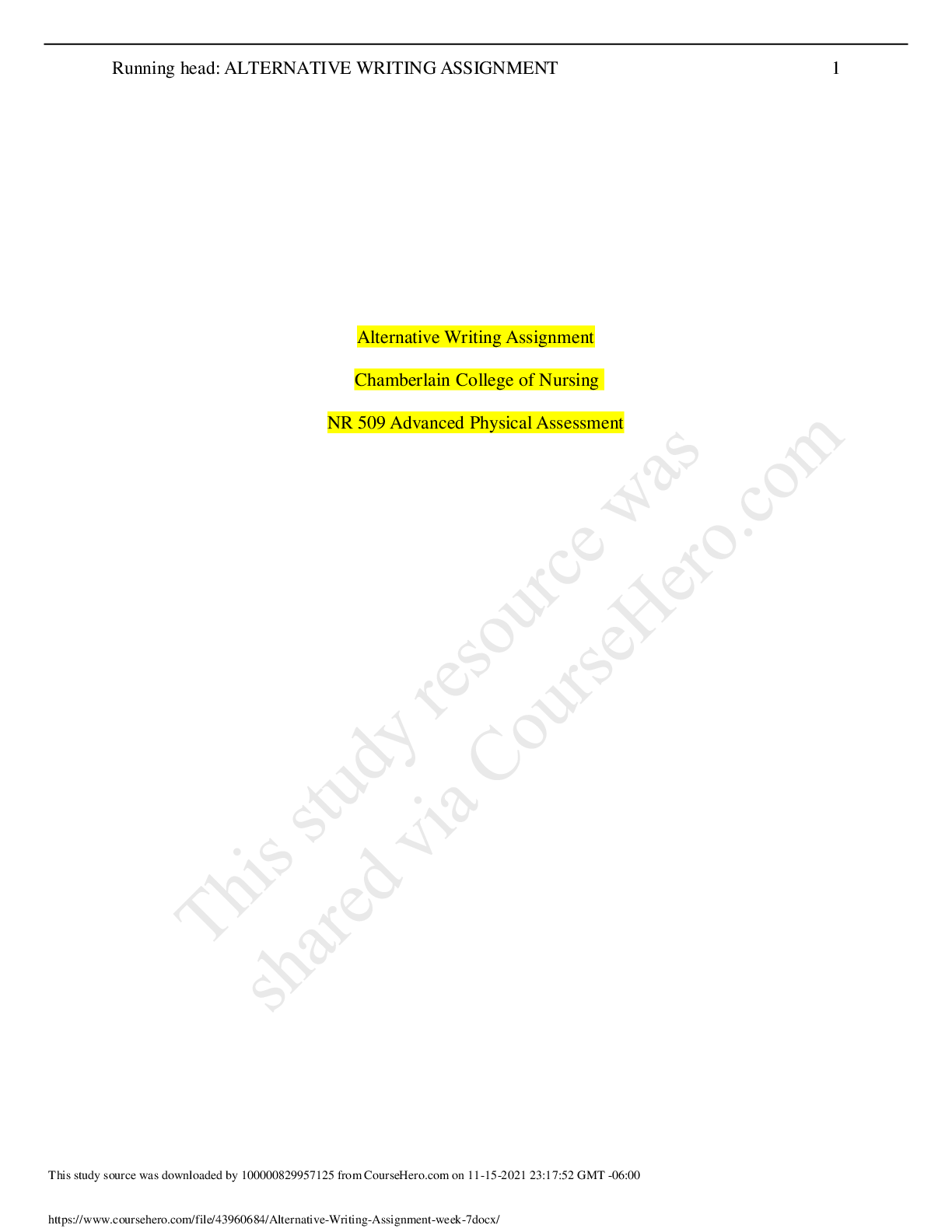
Buy this document to get the full access instantly
Instant Download Access after purchase
Add to cartInstant download
Also available in bundle (1)

NR 509 ALTERNATIVE WRITING ASSIGNMENTS WEEK 1-4, 6-7 ( COLLECTION) | 100% GUARANTEED PASS.
NR 509 ALTERNATIVE WRITING ASSIGNMENTS WEEK 1-4, 6-7 ( COLLECTION) | 100% GUARANTEED PASS.
By Goodluck Academia 2 years ago
$14
5
Reviews( 0 )
Document information
Connected school, study & course
About the document
Uploaded On
Nov 16, 2021
Number of pages
8
Written in
Additional information
This document has been written for:
Uploaded
Nov 16, 2021
Downloads
0
Views
43

